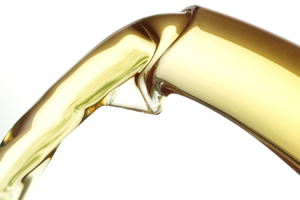The maths behind the annoying teapot effect — and how to prevent it
BLOG: Heidelberg Laureate Forum

If you’ve ever poured tea from a teapot, you may have experienced a rather unpleasant phenomenon: if you don’t hold the teapot carefully and pour at the right angle, there’s a risk that some of the tea will drip down the outside of the teapot instead of pouring properly in your glass. This so-called “teapot effect” has claimed many victims across the years, but why does it happen?
The answer is deceptively complex and the effect has evaded a full explanation — until now.

“Although this is a very common and seemingly simple effect, it is remarkably difficult to explain it exactly within the framework of fluid mechanics,” says Bernhard Scheichl, the author of a new study describing the maths and physics behind this effect.
The teapot effect is frequently observed and seems spontaneous. It doesn’t even necessarily involve a teapot — broadly speaking, it refers to the tendency of liquid pouring from a spout to stick to its underside. The effect was first described in detail by physicist Markus Reiner in 1956. Reiner would go on to become a pioneer of rheology (the study of how fluids flow), but the full explanation of the teapot effect eluded him.
The effect bounced in and out of scientists’ attention for the next few decades. In 1999, professor Jean-Marc Vanden-Broeck of the University of East Anglia, England, and Belgium, was awarded the Ig Nobel prize for physics for calculating how to make a teapot spout that does not drip (the Ig Nobel prizes are a sort of spoof Nobel Prizes that celebrate unusual or trivial achievements in scientific research that “first make people laugh, and then make them think”). That very same year, the teapot drip was also approached by a team of researchers from France.
The French researchers experimented with different ways of making a teapot that doesn’t drip, by employing hydrophobic teapot coatings or wiring the teapot spout to an electrical source. It worked, but it wasn’t very practical and didn’t resolve the underlying questions.
Now, we’ve come full circle: researchers from TU Wien, where Reiner got his doctorate, have published a new study detailing the maths behind this effect.
“We have now succeeded for the first time in providing a complete theoretical explanation of why this drop forms and why the underside of the edge always remains wetted,” says Bernhard Scheichl, one of the study authors.
The physical forces behind the process are relatively straightforward, but the maths describing how these forces work is much more complex. The effect is essentially an interplay between the parameters of the liquid being poured (especially its viscosity), the tensile surface stress to the teapot, and gravitational acceleration. The inertia of the fluid keeps it going in the original direction, while the capillary forces slow the fluid right at the beak. Because of these forces and the surface tension, some of your tea flows where you want it to, while the other drips on the bottom of the teapot. But the geometry of this has to be just right.
“As a rule of thumb, the higher the wettability, the more the fluid ‘sticks’ on the underside and the more the point of three-phase contact or detachment is remote from the plane wall on top,” the researchers write.
Aside from the material of the teapot, the geometry of the edge of the teapot underside beak plays a key role. When drops reach this surface, the area directly below the edge always stays wet and creates tension with the liquid flow. If the speed at which the liquid is poured is high enough, it overrides this tension; but if it’s lower than a critical threshold, this tension can affect the entire flow and pull a part of it around the edge.
This effect only happens at a very specific angle between the wall and the liquid, and at low speeds. The smaller this angle is, the more detachment of the liquid is slowed down. Another interesting finding is that gravity doesn’t really play a role in this phenomenon. Sure, gravity directs where the flows to, but the strength of the gravity doesn’t really play a role in the teapot effect. If you’d pour tea on the Moon or Jupiter, it would detach just as it does on Earth.
“As a major conclusion of our analysis, the layer undergoes its break-away from the trailing edge at its underside when this is geometrically resolved in a least degenerate but most simple manner as a (cut-back) wedge having a rounded nose,” the researchers write.
After detailing the theoretical framework, the research team also put the theory to the test, experimenting by pouring water from an inclined teapot. They used different flow speeds and filmed the results with a high-speed camera, confirming the results. For tea enjoyers, until hydrophobic teapots become popular, the best thing to do is ensure you’re pouring tea at a steady, fast rate.
You can read the entire study and go through the mathematics involved here.
In the meantime, next time you spill tea from your teapot, you’ll at least know how it happens.



Mathematics seems to have a solution for every puzzle and many everyday problems. And yes: once solved with math means solved forever.
I think: there has to be a book somewhere with all the unsolved math Problems in this world. And every year this book gets lighter as more and more pages can be torn out.
Howdy, Herr “Martin Holzherr”,
das eine ist die Mathematik, also eine Formalwissenschaft, die bei der Lösung in der Natur anfallender Probleme helfen kann und nicht selten auch tut, das andere ist die Welt (“everyday problems”), so dass sich einige diesbezüglich unsicher sind : ‘And yes: once solved with math means solved forever.’
Mit freundlichen Grüßen
Dr. Webbaer (der sich zudem vorstellen kann, dass die Menge der ungelösten mathematischen Probleme bis ins Unendliche, sozusagen, wächst, wenn sich derart definitorisch sozusagen ins Unendliche gehend verstärkt bemüht wird)
Frage :
Der Schreiber dieser Zeilen besitzt einen Wasserkocher der Marke “SILVERCREST” (“LIDL”), bei dem dieser Effekt nicht auftritt, dieser Wasserkocher hat wohl genau deshalb, wie im dankenswerterweise bereit gestellten WebLog-Artikel beschrieben, eine sozusagen besonders ergonomisch angelegte “Schnauze”, die wie gemeint auch sehr gut funktioniert, sofern der Kalkfilter gereinigt ist, ansonsten nicht, so dass sich bei anders designten Teekannen sozusagen der beschriebene Effekt gänzlich vermeiden ließe?
Mit freundlichen Grüßen
Dr. Webbaer (der diesem Inhalt insgesamt folgen konnte)
@Dr. Webbaer (Zitat): so dass sich bei anders designten Teekannen sozusagen der beschriebene Effekt gänzlich vermeiden ließe?
Nein, der Teapot effect trifft selbst bei „richtig“ designten Teekannen auf, sobald die Fliessgeschwindigkeit sehr langsam wird – es also nur noch herauströpfelt. Der Teapot effect kann aber durch die richtige Materialwahl des Auslaufes verhindert werden. Dazu muss man den Auslauf aus hydrophobem , am besten sogar superhydrophobem Material, formen. Anstatt von Hydrophobie spricht man im Volksmund oft vom Lotuseffekt und meint damit Material, das sich nicht mit Wasser benetzen lässt, sondern das eine kleine Luftschicht zwischen Wasser und Materialoberfläche ausbildet.
Der Artikel Beating the teapot effect hat eine sehr instruktive Abbildung, die zeigt, wie ein Teekannenauslauf mit Material, welches den Lotuseffekt besitzt, selbst bei Herauströpfeln des Tees ein Anhaften der Flüssigkeit verhindert.
Tipp:Setze den Lotuseffekt am richtigen Ort ein um für alle Situationen gewappnet zu sein.
Bei seinen Wasserkocher tritt der gemeinte Effekt nicht auf, sofern der dem Gerät sozusagen innewohnende sog. Kalkfilter gereinigt bereit steht.
Es leuchtet dem Schreiber dieser Zeilen auch nicht ein, warum hier, wie anscheinend von Ihnen behauptet, “Herr Holzherr”, eine besondere Materialauswahl erfolgen sollte bis muss.
Es muss halt nur angemessen ingenieursmäßig entwickelt worden sein, es ist nicht zwingend anzunehmen, dass es bei derartigem Ausschank wie gemeinten Effekt geben muss.
In früherer Zeit konnte so nicht gelingen, korrekt.
Zur sog. Hydrophobie kennt Dr. Webbaer zuvörderst so :
-> https://wiki.lspace.org/Hydrophobe
Mit freundlichen Grüßen
Dr. Webbaer
PS :
Denkbarerweise ist so alles bereits, im dankenswerterweise hiesig bereit gestellten WebLog-Artikel zusammengefasst :
->’For tea enjoyers, until hydrophobic teapots become popular, the best thing to do is ensure you’re pouring tea at a steady, fast rate.’ [Artikeltext]
Mit freundlichen Grüßen
Dr. Webbaer (der manchmal etwas langsam ist)
@Dr.Webbaer bezüglich Vermeidung des Teekanneneffekts:
1) Der ideale Ausguss ist scharfkantig, hydrophob und am Gefäss so angeordnet, dass die Fliessgeschwindigkeit nie zu klein wird. Darum gibt es Teekannen und Gefässe, deren Ausguss über dem höchsten Flüssigkeitsniveau im Gefäss selbst liegt, denn das sorgt dafür, dass die Flüssigkeit beim Ausgiessen schnell fliesst, muss man doch das Gefäss beim Ausgiessen stärker neigen bis überhaupt etwas ausfliesst.
2) Bei einer schlecht designten Teekanne kann man durch schnelles Ausgiessen den Teekanneneffekt vermeiden oder auch dadurch, dass man die Teekanne nur halb voll füllt, denn je mehr Flüssigkeit eingefüllt ist, desto kleiner ist die Ausflussgeschwindigkeit zu Beginn.
Es gibt noch eine weitere Möglichkeit, den Teekanneneffekt zu vermeiden, nämlich die Konstruktion des Ausgusses der Kanne.
Ich hatte mal eine solche aus Japan, bei der war die Tülle vorn fast 90° nach unten gebogen wie bei einem alten Wasserhahn, man hat also nicht in das Rohr hineingeschaut wie bei unseren “westlichen” Konstruktionen mit “Unterlippe”.
So ist die Flüssigkeit beim Ausgießen immer ziemlich parallel zur Rohroberfläche der Tülle ausgeflossen und die Oberflächenspannung und Benetzbarkeit hatten keine Chance.
Ergänzung: der MIT-Review-Artikel The Death of the Teapot Effect gibt folgende Tipps um den Teekanneneffekt zu besiegen:
Anfällig sind die electric kettles , die schnell verkalken und die Einfüllstutzen an der Tankstelle.
Das Benzin, das nach dem Tanken abtropft, das verdunstet im Sommer , im Winter wird sichtbar wie ungünstig die Einfüllstutzen geformt sind. Hier ist Verbesserung möglich.